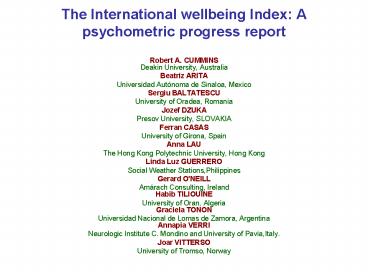The International wellbeing Index: A psychometric progress report
1 / 27
Title:
The International wellbeing Index: A psychometric progress report
Description:
The Hong Kong Polytechnic University, Hong Kong. Linda Luz ... Affect (hedonic balance) = 2,901. Happiness = 25,300. Satisfaction = 28,654. Number of countries: ... –
Number of Views:17
Avg rating:3.0/5.0
Title: The International wellbeing Index: A psychometric progress report
1
The International wellbeing Index A psychometric
progress report
- Robert A. CUMMINS
- Deakin University, Australia
- Beatriz ARITA
- Universidad Autónoma de Sinaloa, Mexico
- Sergiu BALTATESCU
- University of Oradea, Romania
- Jozef DZUKA
- Presov University, SLOVAKIA
- Ferran CASAS
- University of Girona, Spain
- Anna LAU
- The Hong Kong Polytechnic University, Hong Kong
- Linda Luz GUERRERO
- Social Weather Stations,Philippines
- Gerard O'NEILL
- Amárach Consulting, IrelandHabib TILIOUINE
- University of Oran, AlgeriaGraciela TONON
- Universidad Nacional de Lomas de Zamora,
ArgentinaAnnapia VERRI - Neurologic Institute C. Mondino and University of
Pavia,Italy.
2
- This is an initiative of the International
Wellbeing Group. - AIM-1
- To examine the relative psychometric
performance of a standard SWB Index in different
cultural and language groups.
3
AIM-2
- To get beyond simplistic (and misleading)
between-country comparisons of SWB - To build understanding of WHY countries differ in
their SWB
4
Sample Demographics and Method
5
Sample Demographics and Method
6
The theoretical conception of the Index It
represents the First Level Deconstruction of two
global constructs.
7
(No Transcript)
8
Response Scale
Standardized Scale
0-100
Normative population range for Western countries
Personal Wellbeing Index 70-80
9
Factor Analysis
10
Factor Analysis
- All countries tested produce two clean factors
(using an item-loading cut-off score of .4 - BUT, the factors emerge in different orders
11
What causes one factor to be stronger than the
other?
12
SWB Homeostasis
- Our SWB is actively managed by a system that
strives to maintain our level of happiness close
to its genetically determined set-point. - Set-points lie within the positive sector of the
0 100 range - ie. between 50 - 100
13
Proximal Distal Dimension of homeostasis
14
Why does the National Wellbeing Index normally
emerge first as the strongest factor?
15
BUT
- This will only apply if homeostasis it effective.
- In situations of homeostatic defeat, the pattern
will be reversed
16
Prediction
17
Factor Analysis
18
Factor Analysis
Factor Analysis
19
Factor Analysis
Factor Analysis
20
Personal Wellbeing Index
21
Personal Wellbeing Index
22
Steel, P. Ones, D.S. (2000). Journal of
Personality Social Psychology, 83, 767-81.
Compared SWB and Personality
23
Using population mean scores as data
- NEO-PI-R Extraversion Neuroticism
- Predicting affect R² .79
- Predicting SWB (happiness and satisfaction) R²
.64
24
Hierarchical Regression
- Step 1 GDP
- Step 2 SWB R² .76 ?R²
- ie. Personality explains MORE of the variance in
between-nation SWB than does GDP !!
.41
25
Neuroticismvs.Personal Wellbeing Index
26
Extraversionvs.Personal Wellbeing Index
27
Conclusions
- These results are consistent with predictions
based on Homeostasis Theory - 2. In trying to understand why countries differ
in their level of SWB, the variance is at least
as informative as the mean scores. - 3. Extraversion may be a good measure of cultural
response bias


























![Market Report on Global and China Forklift Industry [2015-2017]](https://s3.amazonaws.com/images.powershow.com/8338547.th0.jpg?_=20151230044)




